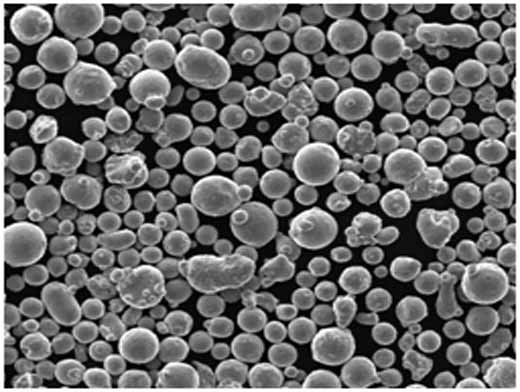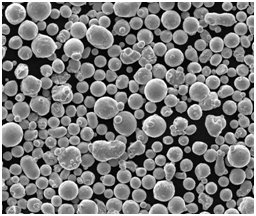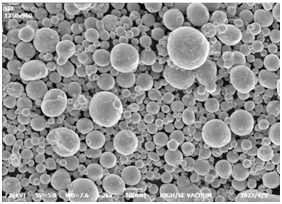내화성 금속 분말 은 현대 재료 과학의 매력적이고 필수적인 부분으로, 다양한 첨단 산업에서 중요한 역할을 담당하고 있습니다. 이러한 소재는 열과 마모에 대한 탁월한 저항성으로 잘 알려져 있어 까다로운 응용 분야에서 매우 귀중한 역할을 합니다. 이 종합 가이드에서는 내화성 금속 분말의 종류, 구성, 특성, 응용 분야 등을 살펴보면서 내화성 금속 분말의 세계를 자세히 살펴봅니다.
내화성 금속 분말 개요
내화 금속 분말은 녹는점이 매우 높고 마모, 부식, 변형에 강한 원소에서 추출한 것입니다. 이러한 금속에는 텅스텐, 몰리브덴, 탄탈륨, 니오븀, 레늄이 포함됩니다. 이러한 금속은 항공우주, 원자로, 고온 용광로 등 극한의 조건을 견딜 수 있는 소재가 필요한 환경에서 활용됩니다.

내화성 금속 분말의 종류
내화성 금속 분말을 완전히 이해하기 위해 몇 가지 특정 유형과 고유한 특성을 자세히 살펴보겠습니다:
| 금속 | 설명 |
|---|---|
| 텅스텐(W) | 녹는점과 밀도가 가장 높은 것으로 알려져 있어 고온 애플리케이션에 이상적입니다. |
| 몰리브덴(Mo) | 열전도율이 우수하고 열팽창이 적어 전자제품 및 조명에 사용됩니다. |
| 탄탈륨(Ta) | 내식성이 뛰어나 의료 기기 및 화학 처리 장비에 사용됩니다. |
| 니오븀(Nb) | 초합금 및 전자제품에 사용되는 높은 연성 및 초전도성. |
| 레늄(Re) | 제트 엔진과 전자제품에 사용되는 높은 융점과 독특한 전기적 특성. |
| 지르코늄(Zr) | 내식성과 강도가 뛰어나 원자로와 의료용 임플란트에 사용됩니다. |
| 하프늄(Hf) | 원자로와 항공우주 부품에 사용되는 높은 중성자 흡수율. |
| 바나듐(V) | 초합금 및 도구에 사용되는 우수한 강도와 내열성. |
| 크롬(Cr) | 코팅 및 초합금에 사용되는 우수한 경도 및 내식성. |
| 티타늄(Ti) | 항공우주, 의료 및 산업 분야에서 사용되는 높은 중량 대비 강도 비율. |
구성 내화성 금속 분말
내화 금속 분말의 구성은 성능에 매우 중요합니다. 이러한 금속은 특정 특성을 향상시키기 위해 다른 원소와 결합되는 경우가 많습니다:
| 금속 | 구성 | 향상된 속성 |
|---|---|---|
| 텅스텐 | 순수 또는 Ni, Fe, Cu 합금 | 향상된 가공성 및 강도. |
| 몰리브덴 | 순수 또는 Ti, Zr, C 합금 | 크리프 저항성과 강도가 향상되었습니다. |
| 탄탈륨 | 순수 또는 W, Hf와 합금 | 향상된 내식성 및 강도. |
| 니오븀 | 순수 또는 Ti, Al 합금 | 초전도성 및 강도 향상. |
| 레늄 | 순수 또는 Mo, W와 합금 | 향상된 열 안정성 및 강도. |
내화성 금속 분말의 특성
내화성 금속 분말은 고성능 애플리케이션에 적합한 고유한 특성을 나타냅니다:
- 높은 융점: 극한의 열을 수반하는 애플리케이션에 필수적입니다.
- 탁월한 경도: 내구성과 내마모성을 제공합니다.
- 고밀도: 스트레스를 받을 때 힘과 안정성에 기여합니다.
- 내식성: 열악한 환경에서도 긴 수명을 보장합니다.
- 열 및 전기 전도성이 우수합니다: 전자 제품 및 고온 애플리케이션에 중요합니다.






내화성 금속 분말의 응용 분야
내화 금속 분말은 뛰어난 특성으로 인해 다양한 산업 분야에서 사용됩니다:
| 산업 | 애플리케이션 |
|---|---|
| 항공우주 | 제트 엔진 부품, 로켓 노즐, 열 차폐막. |
| 전자 제품 | 반도체 장치, 필라멘트, 접점. |
| 의료 | 수술 기구, 임플란트, 치과 기기. |
| 핵 | 원자로 구성 요소, 방사선 차폐, 연료 피복. |
| 화학 처리 | 부식 방지 장비, 촉매, 반응 용기. |
| 산업 | 절삭 공구, 금형, 금형, 내마모성 코팅. |
사양, 크기, 등급, 표준
내화성 금속 분말의 사양과 표준을 이해하는 것은 그 적용에 있어 매우 중요합니다:
| 금속 | 크기(미크론) | 성적 | 표준 |
|---|---|---|---|
| 텅스텐 | 1-100 | W1, W2, W3 | ASTM B777, ISO 4497 |
| 몰리브덴 | 1-50 | Mo1, Mo2, TZM | ASTM B386, ISO 5755 |
| 탄탈륨 | 1-40 | Ta1, Ta2 | ASTM B708, ISO 13782 |
| 니오븀 | 1-60 | Nb1, Nb2, Nb3 | ASTM B393, ISO 13782 |
| 레늄 | 1-20 | Re1, Re2 | ASTM B708, ISO 13782 |
공급업체 및 가격 세부 정보
신뢰할 수 있는 공급업체를 찾고 가격을 이해하는 것은 조달에 필수적입니다:
| 공급업체 | 금속 | 가격(kg당) | 연락처 정보 |
|---|---|---|---|
| 글로벌 텅스텐 | 텅스텐 | $250 | [email protected] |
| 중서부 몰리브덴 | 몰리브덴 | $150 | [email protected] |
| 탄탈륨 공급 | 탄탈륨 | $300 | [email protected] |
| 니오븀 공급원 | 니오븀 | $200 | [email protected] |
| 레늄 레어 | 레늄 | $400 | [email protected] |
내화성 금속 분말의 장점과 한계
내화성 금속 분말은 많은 이점을 제공하지만 몇 가지 제한 사항도 있습니다:
| 장점 | 제한 사항 |
|---|---|
| 고온 내성 | 높은 비용 |
| 뛰어난 기계적 강도 | 기계 가공이 어려움 |
| 우수한 내식성 | 제한된 가용성 |
| 우수한 전기 및 열 전도성 | 무겁고 밀도가 높은 |
| 오래 지속되는 내구성 | 취급 중 발생할 수 있는 건강 위험 |
내화성 금속 분말의 비교
다양한 내화 금속 분말 중에서 선택할 때는 각 분말의 특성과 특정 용도에 대한 적합성을 비교하는 것이 중요합니다:
| 금속 | 녹는점(°C) | 밀도(g/cm³) | 내식성 | 열 전도성(W/m-K) | 애플리케이션 |
|---|---|---|---|---|---|
| 텅스텐 | 3422 | 19.25 | 우수 | 173 | 항공우주, 전자, 조명 |
| 몰리브덴 | 2623 | 10.28 | Good | 138 | 전자, 유리 용융, 조명 |
| 탄탈륨 | 3017 | 16.65 | 우수 | 57 | 의료 기기, 화학 처리 |
| 니오븀 | 2477 | 8.57 | Good | 54 | 초합금, 전자, 의료 |
| 레늄 | 3186 | 21.02 | 우수 | 48 | 제트 엔진, 전자, 화학 |
특정 항목에 대한 상세 분석 내화성 금속 분말
이제 몇 가지 주요 내화성 금속 분말의 고유한 특성, 응용 분야 및 이점을 강조하여 자세히 살펴보겠습니다.
텅스텐 분말
텅스텐 분말은 녹는점과 밀도가 매우 높은 것으로 유명합니다. 따라서 극한의 온도와 기계적 스트레스를 견딜 수 있는 소재가 필요한 분야에 이상적입니다. 텅스텐은 일반적으로 제트 엔진 부품을 위한 항공우주 분야, 필라멘트를 위한 전자 분야, 방사선 차폐를 위한 의료 기기 분야에서 사용됩니다.
몰리브덴 분말
몰리브덴 분말은 열전도율이 우수하고 열팽창이 적은 것으로 알려져 있습니다. 이러한 특성으로 인해 방열판 및 트랜지스터와 같은 전자 제품뿐만 아니라 조명 및 유리 용융 산업에 적합합니다. 고온에서 강도를 유지하는 몰리브덴의 능력은 주요 장점입니다.
탄탈륨 분말
탄탈륨 분말은 내식성이 뛰어나다는 특징이 있습니다. 따라서 화학 처리 및 의료 분야에서 매우 유용합니다. 탄탈륨은 수술 기구, 임플란트 및 부식성이 강한 물질을 취급하는 장비에 자주 사용됩니다. 부식을 견디는 능력은 수명과 신뢰성을 보장합니다.
니오븀 분말
니오븀 분말은 높은 연성과 초전도성으로 유명합니다. 따라서 항공우주 및 전자제품에 사용되는 초합금에 필수적인 구성 요소입니다. 니오븀의 초전도 특성은 낮은 온도와 효율적인 성능을 유지하는 것이 중요한 의료 영상 장치와 입자 가속기에 활용됩니다.
레늄 파우더
레늄 분말은 높은 녹는점과 독특한 전기적 특성으로 높은 평가를 받고 있습니다. 극한의 조건을 견딜 수 있는 소재가 필요한 고온 터빈 엔진과 전자제품에 사용됩니다. 레늄의 뛰어난 열 안정성과 강도는 까다로운 환경에서 매우 중요한 소재입니다.
비교 분석: 텅스텐 대 몰리브덴
텅스텐과 몰리브덴을 비교할 때 두 금속 모두 고온 저항성을 제공하지만 텅스텐의 녹는점(3422°C 대 2623°C)이 더 높아 초고온 응용 분야에서 우위를 점합니다. 그러나 몰리브덴은 열 전도성이 우수하고 밀도가 낮아 효율적인 열 방출과 가벼운 무게가 필요한 응용 분야에 더 적합한 선택입니다.
비교 분석: 탄탈륨 대 니오븀
탄탈륨과 니오븀은 모두 내식성이 뛰어나지만 탄탈륨의 밀도(16.65g/cm³ 대 8.57g/cm³)가 높기 때문에 무게가 덜 중요하고 최대의 내식성이 요구되는 응용 분야에 더 적합합니다. 그러나 니오븀은 연성과 초전도성이 높아 첨단 전자 및 항공 우주 분야에 선호되는 소재입니다.
비교 분석: 레늄 대 텅스텐
레늄과 텅스텐은 모두 고온 응용 분야에 사용되지만 레늄의 고유한 전기적 특성과 높은 가격대로 인해 특수 전자 제품 및 제트 엔진에 이상적입니다. 텅스텐은 밀도가 높고 비용이 저렴하여 일반적인 고온 및 고강도 애플리케이션에 더 실용적입니다.

자주 묻는 질문
| 질문 | 답변 |
|---|---|
| 내화성 금속 분말이란 무엇인가요? | 내화성 금속 분말은 녹는점이 높고 열, 마모, 부식에 대한 저항성이 뛰어난 소재입니다. |
| 내화성 금속 분말의 일반적인 응용 분야에는 어떤 것이 있나요? | 항공우주, 전자, 의료 기기, 원자로 및 화학 처리 장비에 사용됩니다. |
| 내화성 금속 분말은 어떻게 생산되나요? | 일반적으로 기계적 합금, 화학 기상 증착, 금속 산화물 환원 등의 공정을 통해 생산됩니다. |
| 텅스텐 분말의 주요 특성은 무엇인가요? | 텅스텐 분말은 녹는점, 밀도 및 강도가 높아 고온 응용 분야에 이상적인 것으로 알려져 있습니다. |
| 몰리브덴 분말이 전자제품에 사용되는 이유는 무엇인가요? | 몰리브덴 분말은 열전도율이 우수하고 열팽창이 적어 방열판 및 전자 부품에 적합합니다. |
| 탄탈륨 파우더가 부식에 강한 이유는 무엇인가요? | 탄탈륨 분말에는 열악한 화학 환경에서도 부식을 방지하는 보호 산화물 층이 있습니다. |
| 니오븀 분말은 항공우주 분야에서 어떻게 사용되나요? | 니오븀 분말은 높은 강도와 연성으로 인해 제트 엔진 및 기타 고성능 항공우주 부품의 초합금에 사용됩니다. |
| 전자제품에 레늄 분말을 사용하면 어떤 이점이 있나요? | 레늄 분말은 독특한 전기적 특성과 높은 열 안정성을 제공하여 고성능 전자 부품에 이상적입니다. |
| 내화성 금속 분말을 취급할 때 건강상의 위험이 있나요? | 예, 일부 내화성 금속 분말은 흡입하거나 섭취할 경우 건강에 위험을 초래할 수 있습니다. 취급 및 처리 시 적절한 안전 조치를 취해야 합니다. |
| 내화성 금속 분말은 어디에서 구입할 수 있나요? | 내화 금속 분말은 글로벌 텅스텐, 미드웨스트 몰리브덴, 탄탈륨 공급, 니오븀 소스 및 레늄 희귀와 같은 전문 공급업체에서 구매할 수 있습니다. |
결론
적절한 내화 금속 분말을 선택하는 것은 애플리케이션의 특정 요구 사항에 따라 달라집니다. 녹는점, 열전도율, 내식성, 밀도, 비용 등의 요소를 고려하세요. 이러한 특성을 이해하면 정보에 입각한 결정을 내리고 프로젝트의 성공을 보장하는 데 도움이 됩니다.

